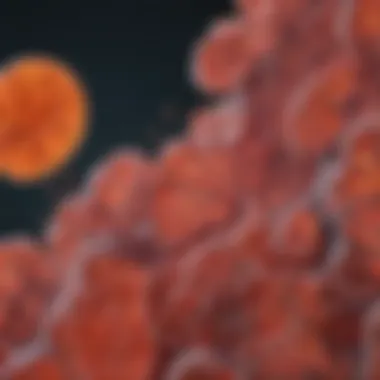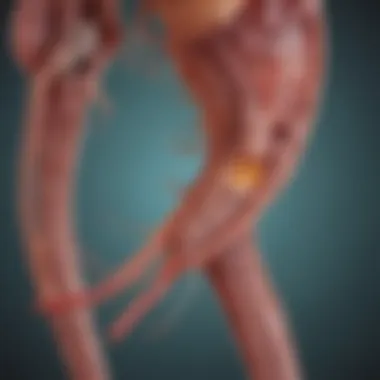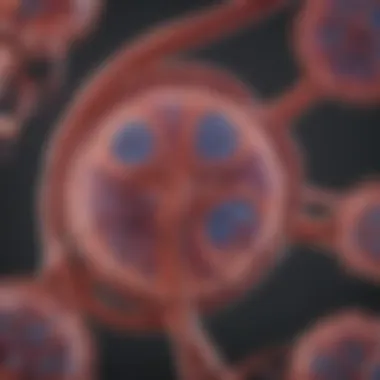In-Depth Insights into IgA Nephropathy


Intro
IgA nephropathy, also known as Berger's disease, is a prevalent form of glomerulonephritis that primarily affects the kidneys. It is characterized by the abnormal accumulation of Immunoglobulin A in the glomeruli, leading to inflammation and damage. The condition manifests differently among individuals, with some experiencing mild or asymptomatic disease, while others may face significant renal impairment.
Understanding this renal condition is crucial for healthcare professionals and researchers alike, as it is one of the most common causes of kidney failure worldwide. Furthermore, recent studies suggest an increasing global incidence of IgA nephropathy, making it imperative to comprehend its underlying mechanisms, clinical presentations, and treatment options.
This article delves deep into the fundamental aspects of IgA nephropathy, offering a comprehensive guide. By examining the research landscape surrounding this disorder, we aim to illuminate the pathophysiological processes involved, whilst addressing the challenges faced in diagnosis and management.
Foreword to IgA Nephropathy
IgA nephropathy is a significant renal condition that requires attention from both medical professionals and researchers. This disorder is primarily marked by the deposition of immunoglobulin A (IgA) within the glomeruli, which are tiny filtering units in the kidneys. Understanding IgA nephropathy is crucial due to its exceedingly variable clinical course, from an asymptomatic patient to one who may progress to end-stage renal disease. Exploring this topic provides valuable insights into the pathophysiological mechanisms at play, along with the epidemiological factors that contribute to its prevalence.
One important aspect of IgA nephropathy is its global impact. With varying incidences across populations, awareness of this condition can help inform public health strategies and promote better patient outcomes. Given its chronic nature, timely diagnosis and management are essential. The implications of IgA nephropathy extend beyond individual well-being, as it has economic and social ramifications for healthcare systems.
Employing a comprehensive approach in this article allows for a thorough exploration of IgA nephropathy. Key elements include the role of genetic predispositions and environmental triggers, which shape the risk profile for this disease. By delving into clinical presentation and diagnostic methods, practitioners can enhance their understanding and improve patient care.
Furthermore, a discussion on modern treatment strategies will equip clinicians with the necessary tools to address this complex disorder. Future research is also a pivotal topic, particularly as advancements in diagnostics and therapeutics may lead to more effective management options.
"Recognizing the multifaceted nature of IgA nephropathy is essential to advance both our knowledge and our treatment strategies."
In summary, IgA nephropathy is not merely a clinical label but a complex interplay of immunological processes, environmental influences, and individual patient factors. This article aims to equip readers with a complete understanding of the disorder, guiding them through the intricacies of IgA nephropathy.
Pathophysiology of IgA Nephropathy
Understanding the pathophysiology of IgA nephropathy is crucial for comprehending the mechanisms driving this renal disorder. This section discusses the fundamental processes, disorders related to immunoglobulin A, and the implications these have for disease progression and treatment options. The pathophysiological basis provides insights into targeted therapeutic strategies and helps inform clinical practices.
Immunoglobulin A and its Role
Immunoglobulin A (IgA) is a key antibody involved in mucosal immunity, mainly present in the secretions of bodily fluids. In the case of IgA nephropathy, there is an abnormal accumulation of this immunoglobulin in the glomeruli of the kidneys. This aberrent deposition triggers inflammatory responses that contribute to kidney damage over time. Research points to potential defects in the glycosylation of IgA molecules, which can promote their recognition by immune cells, leading to further inflammatory processes in the kidney structures. This abnormality illustrates why IgA's role is central to the development of the condition.
Mechanisms of Glomerular Injury
The mechanisms underlying glomerular injury in IgA nephropathy are multifaceted. One significant mechanism is the activation of complement pathways, which may augment inflammation in renal tissues. Activated immune cells, including T cells and macrophages, infiltrate the glomeruli, escalating damage through various pathways such as cytokine release. Furthermore, the production of pro-inflammatory cytokines fosters an environment conducive to fibrosis. As the disease advances, persistent glomerular inflammation leads to scarring and may ultimately result in chronic kidney disease.
In summary, understanding these mechanisms elucidates why individuals with IgA nephropathy may experience variable rates of progression and different clinical outcomes.
Role of Genetic Factors
Genetic predispositions play a role in the onset and progression of IgA nephropathy. Specific alleles in the human leukocyte antigen (HLA) complex have been associated with an increased risk of developing this condition. Some studies indicate that these genetic factors can influence the immune response, particularly in how IgA is produced and processed within the body. This highlights the importance of genetic research in identifying individuals at risk and developing personalized treatment approaches.
To continue research efforts, there is a dire need for large-scale genetic studies to further characterize the role of genetics, which could open new avenues for understanding mechanisms of action and potential therapeutic targets.
Epidemiology
Epidemiology serves as a cornerstone in understanding the patterns, causes, and effects of health and disease conditions in specific populations. In the context of IgA nephropathy, it highlights the prevalence and incidence rates, demographic influences, and geographic variations of the disease. These epidemiological insights are not merely academic; they directly inform clinical practices, guide public health initiatives, and shape future research endeavors.
Global Prevalence and Incidence


The global prevalence of IgA nephropathy varies significantly. Estimates suggest that it affects approximately 2% to 3% of the general population, though some regions report higher rates. In Asia, particularly in countries like Japan and South Korea, the prevalence can exceed 10%. This variation in incidence rates may relate to both genetic predispositions and environmental factors. Notably, IgA nephropathy is recognized as one of the most prevalent forms of primary glomerulonephritis worldwide. Its diagnosis often follows an incidental finding during routine urine examination, leading to a challenge in exact prevalence statistics.
Demographic Factors
Demographic factors play a significant role in the presentation of IgA nephropathy. The disorder is more common in males than females, with a male-to-female ratio of approximately 2:1. Age also influences IgA nephropathy risk, as it tends to occur predominantly in individuals between the ages of 15 and 35. This demographic insight suggests that younger individuals experience the highest incidence of this renal condition. Furthermore, observations indicate variations based on ethnicity; for example, East Asian populations show notably higher occurrence rates compared to populations of European descent.
Geographical Variations
Geographical variations present another layer of complexity in understanding IgA nephropathy. Different regions exhibit distinct prevalence rates and disease manifestations. For instance, in Europe, the rates are generally lower compared to Asia. Various studies suggest that environmental factors, including exposure to certain infections or dietary habits, may contribute to these geographical discrepancies. Regions with significant exposure to environmental pollutants or differing lifestyles may experience heightened incidence rates, indicating a possible link between these factors and the disease's development. This understanding can provide insight into where to focus public health resources and research efforts.
Understanding the epidemiology of IgA nephropathy is crucial not only for medical professionals but also for researchers aiming to uncover the underlying causes and potential preventive measures.
Given these insights, researchers and healthcare professionals must remain vigilant about the demographic and geographical factors influencing IgA nephropathy. This knowledge allows for better-targeted interventions and enhances the overall management of the disease.
Clinical Presentation
The clinical presentation of IgA nephropathy is a critical element in understanding this condition. Recognizing the symptoms and diseases course can greatly influence diagnosis and management strategies. This section will elaborate on the key symptoms and signs of IgA nephropathy, its progression, and potential complications associated with the disease. Awareness of these factors is vital for healthcare professionals and researchers in formulating effective patient care and expanding research in this area.
Symptoms and Signs
IgA nephropathy often manifests with a variety of symptoms. The most notable symptom is hematuria, which is the presence of blood in urine. This can be visible (gross hematuria) or detectable only under a microscope (microscopic hematuria). Proteinuria is another symptom, indicating an increase in protein levels in the urine. It may not be visible, but it serves as a significant indicator of kidney impairment.
Some individuals experience swelling in various body parts, particularly in the legs and around the eyes, which is due to fluid retention. Fatigue and general malaise are also common, reflecting the reduced kidney function and its impact on overall health.
"Recognizing the early signs of IgA nephropathy is essential in mitigating long-term kidney damage."
Disease Progression
Understanding the disease progression of IgA nephropathy is crucial for predicting outcomes and guiding treatment. This disease often follows a variable course, with progression affected by a range of factors including proteinuria severity, blood pressure, and renal function at the time of diagnosis.
Initially, many patients may experience few to no symptoms, leading to incidents of diagnosis becoming somewhat accidental during routine testing. However, as the disease advances, individuals may develop chronic kidney disease, potentially leading to end-stage renal failure.
Regular monitoring is essential. It allows for timely interventions to slow the disease's progression through lifestyle modifications and medical treatment.
Complications Associated with IgA Nephropathy
While IgA nephropathy can be managed effectively, several complications may arise if it progresses unchecked. Some of the notable complications include:
- Chronic Kidney Disease: A large number of patients eventually develop chronic kidney issues, which may progress to end-stage renal disease.
- Cardiovascular Issues: There is an increased risk of hypertension and other cardiovascular problems due to altered kidney function.
- Infections: Patients undergoing treatments, such as immunosuppressive therapy, may face elevated risks of infections.
Management of these complications calls for careful monitoring and may require hospitalization in severe cases. An interdisciplinary approach is often necessary to provide comprehensive care.
In summary, the clinical presentation of IgA nephropathy, including its symptoms, progression, and complications holds significant relevance for effective diagnosis and management. Understanding these elements helps healthcare providers adopt a proactive approach in treating their patients and advancing research.
Diagnosis of IgA Nephropathy
Diagnosing IgA nephropathy is a critical step in managing this kidney condition. The process involves evaluating clinical symptoms, utilizing laboratory tests, employing imaging techniques, and analyzing kidney biopsy findings. Each component contributes to forming a comprehensive view of the disease, helping to differentiate it from other renal disorders.


Clinical Evaluation
Clinical evaluation begins with a detailed medical history and physical examination. Patients may present with symptoms such as hematuria, proteinuria, and hypertension. Hematuria is often noticeable as blood in urine, typically resulting in a reddish or tea-colored urine. Healthcare providers look for the pattern and persistence of symptoms to establish a timeline of the disease progression. Additionally, family history of renal disease should be assessed, as it can hint at genetic predispositions. This initial evaluation helps to form the basis for further diagnostic investigations.
Laboratory Tests
Laboratory tests play an essential role in confirming the presence of IgA nephropathy. Common tests include urinalysis, serum creatinine levels, and serum IgA levels. Urinalysis can reveal red blood cells, white blood cells, and proteins. Elevated serum creatinine indicates impaired kidney function. Importantly, elevated immunoglobulin A levels can support the diagnosis, but not all patients with IgA nephropathy have elevated IgA levels, making this test less definitive. Additional tests such as complement levels and autoantibody panels might be ordered to exclude other renal conditions, providing a clearer context for the diagnosis.
Imaging Techniques
Imaging techniques are valuable in understanding the structural integrity of the kidneys. Ultrasound is commonly used to assess kidney size and detect any abnormalities. It is non-invasive and helps rule out obstructions and major anatomical issues. In certain situations, a CT scan may be employed. Contrarily, MRI is less frequently used but can provide detailed images of kidney structures when necessary. Although imaging techniques do not confirm IgA nephropathy, they can help in ruling out other renal disorders, shaping the overall diagnostic approach.
Kidney Biopsy Findings
A kidney biopsy is often the definitive method for diagnosing IgA nephropathy. This procedure involves removing a small kidney tissue sample for histological examination. Pathologists look for characteristic features such as mesangial deposition of IgA and complement components. Immunofluorescence microscopy reveals the pattern of IgA deposition, essential for a conclusive diagnosis. The results from the biopsy not only confirm IgA nephropathy but also provide insights into the severity of the damage, which is critical for developing a management plan.
The correct diagnosis of IgA nephropathy is essential for formulating an effective treatment strategy and optimizing patient outcomes.
Management and Treatment
Managing IgA nephropathy requires a multifaceted approach. This is crucial for slowing disease progression, preserving kidney function, and improving the quality of life for affected individuals. The treatment plan may vary based on the severity of the disease, patient symptoms, and underlying health conditions. Key elements include supportive care, pharmacological interventions, dietary considerations, and ongoing monitoring.
Supportive Care Approaches
Supportive care is foundational in managing IgA nephropathy. Patients often need to manage their overall health to aid kidney function. Blood pressure control is paramount. Elevated blood pressure can worsen kidney damage, so monitoring and management are vital. Physicians frequently recommend lifestyle modifications, such as regular exercise and a low-sodium diet.
Importantly, patient education is part of supportive care. Patients should understand their condition, treatment options, and ways to maintain kidney health. Regular follow-ups with healthcare providers can help track symptoms and manage any complications that arise.
"Effective supportive care can significantly enhance quality of life and prevent further kidney damage in IgA nephropathy patients."
Pharmacological Treatments
Pharmacological treatment is critical in controlling symptoms of IgA nephropathy and managing its progression. Angiotensin-converting enzyme inhibitors (ACE inhibitors) and angiotensin receptor blockers (ARBs) are commonly used to lower blood pressure and provide renal protection. Their role extends to reducing proteinuria, a common symptom associated with this disorder.
Corticosteroids may also be prescribed in cases of severe disease. They help reduce inflammation in the kidneys. Immunosuppressants might be another option if steroids alone do not manage symptoms effectively. However, the use of these drugs must be carefully monitored due to potential side effects.
Dietary Considerations
Diet plays a nuanced role in managing IgA nephropathy. A low-protein diet may be recommended to reduce kidney workload. This approach can help slow the progression of the disease in some patients.
Low-sodium intake is important for controlling blood pressure, while a balanced diet rich in fruits, vegetables, and whole grains supports overall health. Hydration is essential, but fluid intake should be balanced depending on kidney function. Consultation with a nutritionist can tailor dietary plans to individual needs.
Monitoring Disease Progression
Ongoing monitoring is crucial. Regular kidney function tests, urinalysis, and blood pressure checks help assess the disease's progression. Patients should have periodic visits with their nephrologist to evaluate their treatment response.
Home monitoring of blood pressure and symptoms can empower patients. Furthermore, awareness of new symptoms or changes in urination patterns can prompt timely responses, which is vital in preserving kidney function.


Potential Advances in Research
Research in IgA nephropathy continues to evolve, emphasizing the integration of innovative approaches for better understanding and treatment of this complex renal disorder. Exploring avenues such as novel biomarkers, gene therapy, and clinical trials can lead to significant advancements in patient care and management strategies. This section discusses these potential advances in detail, focusing on their implications for future research and clinical practice.
Novel Biomarkers
The identification of novel biomarkers is critical in the context of IgA nephropathy. Current diagnostics often rely on serological tests and kidney biopsy, both of which can be invasive. The discovery of non-invasive biomarkers could streamline the diagnosis process, enhance monitoring of disease progression, and tailor therapies to individual patient needs.
Biomarkers like urinary acetylated glucosaminoglycans, or specific microRNAs, are being investigated for their roles in disease activity. Incorporating these markers into clinical practice could revolutionize the management of IgA nephropathy by providing insights into therapeutic efficacy and renal prognosis.
Gene Therapy Approaches
Gene therapy represents a promising frontier in treating IgA nephropathy. The underlying genetic factors contributing to the disease are gaining more understanding, highlighting the potential for targeted genetic interventions. By modifying or correcting specific gene mutations associated with IgA production and deposition, it may be possible to alter the disease course.
Current strategies include approaches aimed at silencing genes that promote IgA synthesis or enhancing the pathways responsible for its clearance. Although still in early research phases, these gene therapy techniques raise hopes for a future where treatments can be customized based on a patient’s genetic profile.
Clinical Trials and Emerging Therapies
Clinical trials play an essential role in advancing the treatment landscape for IgA nephropathy. Ongoing trials are investigating various pharmacological interventions and their applicability in altering disease progression or improving renal outcomes.
Newer therapies, such as monoclonal antibodies targeting specific pathways involved in IgA nephropathy, show promise. These approaches aim to reduce inflammation and suppress the immune response that drives the disease. Encouraging results from trials can lead to the introduction of effective therapies, potentially changing the standard of care.
"The future of managing IgA nephropathy may be defined by our ability to adapt treatment strategies based on emerging research and patient-specific information."
In summary, the exploration of novel biomarkers, gene therapy, and clinical trials reflects an active commitment to understanding and treating IgA nephropathy effectively. As this field progresses, the integration of these advances promises to enrich the patient care landscape significantly.
The End and Future Directions
The section on Conclusion and Future Directions provides a crucial synthesis of the various elements discussed throughout this article on IgA nephropathy. It is imperative to analyze and reflect on the findings presented, as they offer insights that are vital for understanding the complexities of this renal disorder. The overarching goal is not just to culminate the discussion but to lay the groundwork for future developments in the field. Understanding IgA nephropathy's mechanisms, clinical implications, and management strategies leads to better patient outcomes and encourages ongoing investigation into its pathophysiology.
Summary of Key Findings
The exploration of IgA nephropathy reveals several key findings that contribute to the broader understanding of this disease:
- Pathophysiological Mechanisms: Immunoglobulin A plays a significant role in the pathogenesis, with its deposition in the glomeruli leading to inflammation and subsequent renal impairment.
- Epidemiological Data: The global prevalence indicates a growing health concern, emphasizing the necessity for awareness among healthcare providers.
- Clinical Presentation: Recognizing symptoms early is essential for timely diagnosis and management. Awareness of disease progression and potential complications is crucial for optimizing treatment plans.
- Diagnosis and Management: A multifaceted approach that includes clinical evaluation, laboratory tests, and renal biopsy is important for accurate diagnosis. Management strategies focus not only on symptom relief but also on slowing disease progression.
- Future Research Directions: The identification of novel biomarkers and gene therapy approaches can pave the way for innovative treatments, enhancing patient care significantly.
Calls for Further Research
The urgency for continued research in IgA nephropathy cannot be overstated. While current understanding has advanced considerably, numerous areas still require exploration:
- Investigating Biomarkers: Identifying specific biomarkers can improve diagnostic accuracy and facilitate personalized treatment strategies.
- Longitudinal Studies: Conducting extensive longitudinal studies will provide deeper insights into disease progression and long-term outcomes for patients.
- Exploration of Genetics: Further investigation into genetic factors may unravel predisposition to IgA nephropathy, guiding preventive measures and targeted therapies.
- Clinical Trials for Emerging Therapies: Sponsoring more clinical trials focusing on newer therapeutic agents can optimize personal treatment plans and improve existing models.
- Global Collaboration: Engaging in global health initiatives will help share resources, data, and expertise to tackle the disparities in IgA nephropathy detection and treatment.
Acknowledgments
This article on IgA nephropathy would not have been possible without the substantial contributions from various individuals and organizations. Acknowledgments serve several critical functions in scholarly writing. They provide recognition to those who have facilitated or influenced the research presented in the article. It's an opportunity to express gratitude to researchers, practitioners, and patients who have played a role in advancing the understanding of IgA nephropathy.
One key aspect of acknowledgments is the acknowledgment of funding sources. Research in the field of nephrology often relies on grants and financial support from different institutions or organizations. Recognizing these sources underscores the support for scientific research and emphasizes the collaborative nature of medical advances.
Moreover, acknowledging the efforts of peer reviewers enhances the credibility and integrity of the article. These experts contribute insights that refine the argument and elevate the discourse surrounding IgA nephropathy. Their critiques may challenge authors to improve their work, ultimately benefiting the wider academic community.
Additionally, support from professional networks and associations facilitates knowledge sharing. Initiatives from organizations dedicated to renal health encourage public engagement and facilitate research collaboration. Their work promotes awareness of conditions like IgA nephropathy, impacting patients' lives positively.
Patients and advocacy groups also deserve mention. Their experiences provide invaluable context and urgency to scientific inquiry. Through personal stories, they highlight the need for research and better treatment options. Recognizing these perspectives brings a human element to medical studies and urges researchers to prioritize patient-centered outcomes.
In summary, acknowledgments in this article serve to honor contributions from funding bodies, peers, and stakeholders in the medical community. They fortify the foundation upon which the article stands, illustrating the importance of collaboration in advancing our understanding of IgA nephropathy and related renal disorders.















